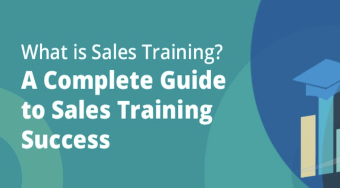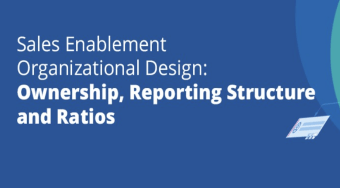As sales enablement professionals, we need to have crystal clear clarity around what problems we are solving and what sales metrics are most important to sales enablement. Access to performance data and transparency around sales metrics helps in getting aligned with senior leaders. It stops us from doing busy work versus the work that really matters. It helps us be better enablers. It helps us run better sales enablement programs.
- How can we make executive level recommendations and decisions without factual data?
- How do we deliver shareholder value if we do not understand the growth levers?
- How can we do our jobs if we are not armed with the right data?
Sales Enablement KPIs – The Key Metrics for Sales Enablement
Here are the top sales enablement metrics benchmarks we need to understand and use in our sales enablement programs:
Sales Enablement Metric #1: Quota Attainment
Quota attainment is a measure of sales rep performance. The top deliverable of sales enablement is to help bring salespeople to peak performance. We measure whether our teams reached their sales targets in a given period, or not. If they have reached their goal, they have attained quota. Conversely, if the team has only achieved 50% quota attainment, then half have reached their quotas. Any time our sales enablement program lifts our team’s ability to hit quota, top-line will be massively impacted. Know this number and know where you stand as an organization. Review these numbers quarterly and monthly by seller, by manager, by segment, and by tenure.
Sales Enablement Metric #2: Distribution of Quota Attainment
The percentage of salespeople who hit quota is a very important metric. It highlights a healthy business if the distribution of people hitting their quota sales attainment is high. Another metric to look at is the percentage of salespeople who are rewarded with a sales incentive club recognition award. We want to avoid is a small number of people crushing their numbers and carrying the team. That is not a healthy state of a business.
Sales Enablement Metric #3: Win/Loss Rates
We want to help our teams always beat the competition. Why should we strive for anything less than a perfect win rate score? Know your team’s win/loss rates by competitor, by manager, and by seller. To calculate your winning percentage, get the total number of deals by adding your wins and losses together. From there, divide the number of wins by the total number of deals. It is good to know deal win rates to better predict resources needed to hit quota. Knowing win-rates will tell us how many leads need to be created and how many active deals need to be worked per period to exceed numbers.
Sales Enablement Metric #4: Sales Cycle Time
The number of days in a sales cycle is material to a company’s ability to predict revenue and forecast accurately. We want to measure how long it takes teams to close deals. When deals take longer than expected we look for clues as to why. Perhaps the seller is not executing the sales process effectively or perhaps the sales playbook is not being followed. Either way, the time it takes to close deals is critical for enablement professionals to gage the efficacy of enablement initiatives. It is good to look at sales cycle time in aggregate and by sales stage conversion as well. Getting more granular will provide more specificity on resourcing and investment needed to drive enablement outcomes.
Sales Enablement Metric #5: Deal Size
When salespeople are competently taking their customers through the sales process and buyer’s journey to do proper discovery, they close bigger deals. Why? The relationship building and deeper questions asked results in higher value and less discounting. Knowing the numbers and knowing the winning actions is another enablement multiplier that can be measured and influenced. Average selling price is also a derivative of this sales enablement metric.
Sales Enablement Metric #6: Time To Ramp
Cutting down time to ramp is one of the primary parameters that can help to prove the effectiveness of onboarding efforts. This onboarding metric is critical to measure and important to define clearly. It is broadly measured by the amount of time it takes new hires to be fully productive. For salespeople, time to ramp means the amount of time it takes to hit quota. There are ways to measure leading indicators like off-ramp quota, time to first deal and time to second deal. I suggest looking for early indicators to avoid finding out too late that your teams are not cutting it and being productive.
Sales Enablement Metric #7: Employee Attrition
Employee turnover is a big problem in corporations today, and extremely costly. Employee retention should be a top metric and priority. We spend billions of dollars hiring, recruiting and developing our people. We want to know how many employees are leaving every year to understand the true cost of employee attrition. Do not forget to include the opportunity cost of deals not closed during that time period as well.
Sales Enablement Metric #8: Employee Engagement
Increasingly more and more, companies are realizing that their employees are not engaged. Worse, they feel like their managers are not engaged in their professional and career development. There are a couple ways to measure engagement. We can measure employee satisfaction or net promoter score. Both are easily tracked and benchmarked. We can also measure coaching activity by employee and manager. The correlation of employee engagement to attainment and results is a great way to profile top performers.
Sales Enablement Metric #9: Content Effectiveness
Knowing which content is working and which content isn’t is extremely important in sales and marketing leadership. We want to measure content consumption like views, downloads, and ratings, and compare those metrics to revenue. This helps marketing and subject matter experts know if their work is making an impact. Tying knowledge and content consumption back to closed or lost deals is the holy grail of content enablement metrics. The combination of content consumption data with revenue data and CRM data will begin to tell a story around what content may have lead to a closed or lost deal.
Sales Enablement Metric #10: Customer Facing Selling Time
It is a general common principle. The more time our sales teams have to sell, the more they will close. However, it’s hard to measure. One way is by surveying teams and asking them. Doing an annual survey measuring and benchmarking customer facing selling time is a great way to get this done.
Now that we have a clearer understanding of the metrics that matter, how to measure enablement efforts, and how those efforts effects outcome, we are better prepared to have data driven enablement conversations to drive our enablement strategies and tactics.
Every sales enablement strategy meeting should start with a review of the metrics. Have the data handy and be ready to look at attainment and productivity results by team. I would even come prepared with a printout ready for everyone to review and discuss together. Having this data will elevate your game. There is another benefit of mastering the data and sales enablement goal metrics and promoting the results: You’ll get universal buy-in from executives and your teams for your sales enablement initiatives.




